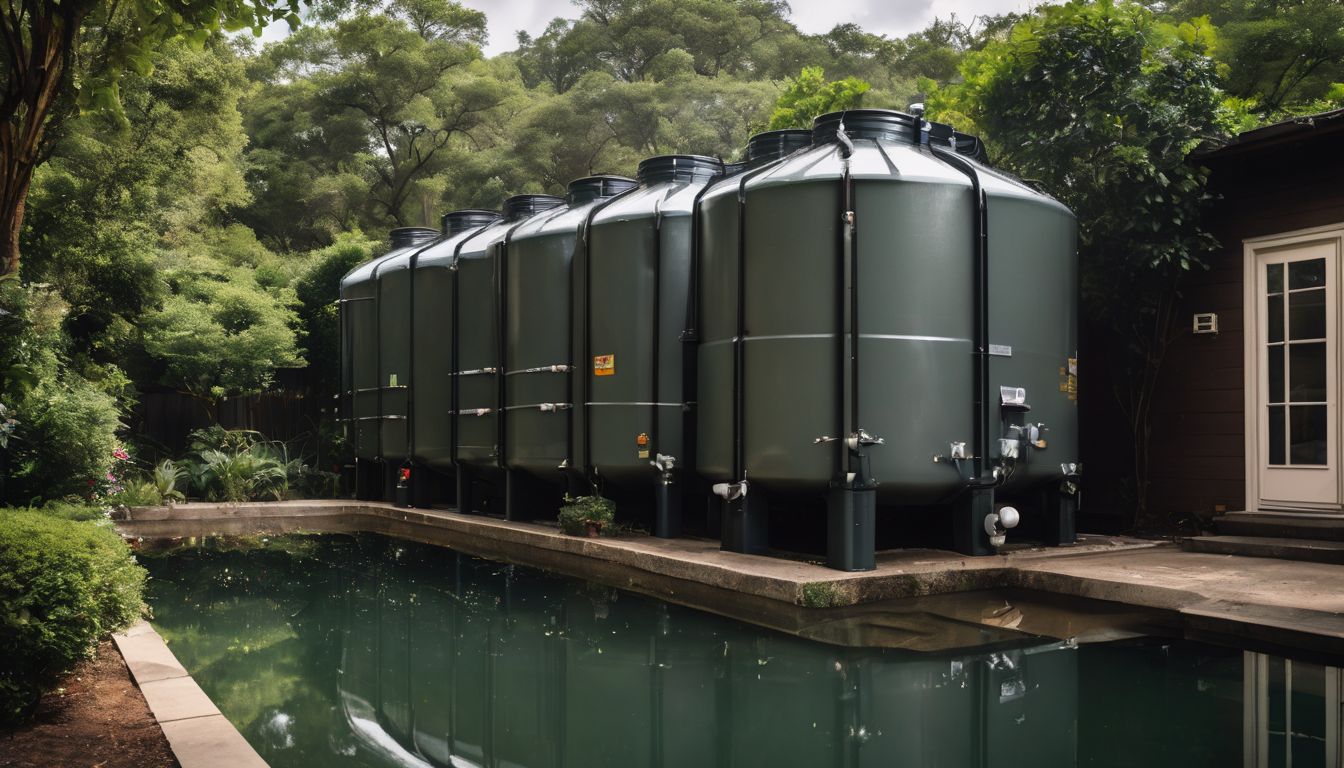As energy bills soar, many of us are seeking ways to cut costs and save the environment. A community energy audit can pinpoint where we’re losing energy and how we can stop this. Our guide will show you the steps to assess your community’s energy use, leading to practical changes for efficiency gains.
“Let’s get started on saving money and our planet!”.
Key Takeaways
- Conducting a community energy audit helps identify where homes are losing heat or energy, allowing residents to make changes like sealing air leaks and upgrading appliances, which leads to lower energy bills.
- There are various types of energy audits: DIY assessments, professional home evaluations, and community-based programs. Each type provides insights into improving home energy usage with the help of tools such as blower door tests and thermographic scans.
- Community involvement is crucial for effective energy audits. Training residents in identifying inefficiencies can lead to collective action and substantial improvements in the community’s overall sustainability.
- Upgrading heating and cooling systems, using LED lighting, choosing ENERGY STAR – rated appliances, and considering renewable sources like solar panels significantly boost a home’s efficiency.
- After an audit, accessing resources like local environmental authorities for guidance on conservation efforts ensures continued progress towards sustainable living within the community.
Benefits of Conducting a Community Energy Audit
Lower energy bills, increased sustainability and improved air quality are just some of the benefits of conducting a community energy audit. This can help individuals and communities save money while reducing their environmental impact.
Lower energy bills
By conducting a community energy audit, residents pinpoint where their homes are losing heat or wasting electricity. With this insight, they take steps to improve insulation, seal up air leaks, and upgrade to more energy-efficient appliances.
The immediate benefit comes in the shape of reduced monthly energy costs.
Energy assessments often reveal simple fixes that lead to significant savings on bills. For example, replacing outdated light bulbs with LED ones can cut down a home’s lighting expenses by up to 80%.
These collective efforts not only keep more money in homeowners’ pockets but also contribute toward a greener and more eco-friendly neighborhood.
Increased energy efficiency and sustainability
To increase energy efficiency and sustainability in your community, consider upgrading to energy-efficient appliances and lighting. Switching to LED bulbs, ENERGY STAR-rated appliances, and smart home devices can significantly reduce your household’s energy consumption.
Additionally, weatherising your home by sealing air leaks, insulating lofts and crawl spaces, and installing programmable thermostats are effective ways to improve energy efficiency.
Furthermore, considering renewable energy sources such as solar panels or wind turbines for power generation can contribute to a more sustainable community.
When aiming for increased energy efficiency and sustainability in your local area, it is vital to educate yourself on available incentives for eco-friendly upgrades. Research government rebates or tax credits that may be applicable when making environmentally conscious improvements.
Moreover, spreading awareness about the benefits of these initiatives within your neighbourhood can encourage collective action towards a greener community.
Improved air quality
Improving air quality is a key benefit of conducting a community energy audit. Identifying and addressing sources of pollution can lead to cleaner, healthier air for everyone in the area.
By reducing energy consumption and implementing more sustainable practices, you can help reduce harmful emissions from heating systems and appliances, contributing to a greener and healthier environment.
Moving on to “Types of Energy Audits”..
Types of Energy Audits
When it comes to conducting a community energy audit, there are different types of assessments to consider. These include DIY home energy assessments, professional home energy assessments, and community-based home energy tune-up/audit programs.
Each type offers its own benefits and can be tailored to the specific needs of the community.
DIY Home Energy Assessments
Conducting a DIY home energy assessment is a practical and cost-effective way to identify areas for improvement in energy usage. You can easily start by taking the following steps:
- Inspect insulation: Check for any gaps or damage in your insulation to prevent heat loss.
- Assess air leaks: Use a candle or incense stick to detect drafts around windows, doors, and electrical outlets.
- Review heating and cooling systems: Clean or replace air filters regularly to ensure optimal efficiency.
- Evaluate lighting and appliance usage: Switch to energy-efficient LED bulbs and unplug electronic devices when not in use.
- Consider renewable energy sources: Explore options like solar panels or wind turbines for sustainable power generation.
Professional Home Energy Assessments
Professional Home Energy Assessments are conducted by certified energy auditors who assess the energy usage and efficiency of a home. They use advanced tools and techniques to provide a comprehensive analysis of the home’s energy consumption. During a professional home energy assessment, auditors examine the insulation, heating and cooling systems, appliances, lighting, and air leakage points to identify areas for improvement.
- Certified Energy Auditors: These professionals have the expertise and training to conduct thorough assessments using industry-standard practices and equipment.
- Advanced Tools: Professional assessments often involve the use of specialised tools such as infrared cameras, blower door tests, and data loggers to gather detailed information about energy usage and potential areas for improvement.
- Comprehensive Analysis: The assessment includes a detailed report outlining specific recommendations for improving energy efficiency, reducing utility costs, and enhancing overall comfort within the home.
- Identification of Energy Loss: Through thermal imaging and air leakage testing, professionals can pinpoint areas where valuable energy is being lost due to poor insulation or draughty windows and doors.
- Customised Recommendations: Based on the findings of the assessment, auditors provide tailored recommendations for upgrades or modifications to achieve greater energy savings and environmental sustainability.
- Follow-Up Support: Professional assessors often offer follow-up support to guide homeowners through the implementation of recommended improvements and measure their impact over time.
- Cost Savings Analysis: Along with identifying potential energy savings opportunities, auditors can quantify the financial benefits of implementing recommended measures in terms of reduced utility bills.
Community-Based Home Energy Tune-Up/Audit Programs
Community-based home energy tune-up/audit programs offer a collaborative approach to improving energy efficiency in a community. These programs engage residents in assessing and addressing energy usage in homes, leading to collective environmental impact. Participants receive training and tools to conduct home energy assessments, empowering them to make informed choices for creating sustainable living spaces.
- Engaging Community Members: Programs encourage active participation from local residents, fostering a sense of shared responsibility for energy conservation.
- Training and Education: Residents are equipped with the knowledge and skills needed to identify energy inefficiencies and implement solutions.
- Collaborative Action: Through collective efforts, communities can significantly reduce overall energy consumption and environmental impact.
- Resource Sharing: Participants benefit from sharing experiences, best practices, and resources for enhancing energy efficiency at the community level.
- Support Network: These programs provide a support network for individuals to seek guidance, exchange ideas, and collaborate on sustainable initiatives.
Steps for Conducting a Community Energy Audit
Research and gather information, design and deliver training, and implement an evaluation process to ensure the success of your community energy audit. To learn more about how to conduct a comprehensive energy assessment for your neighborhood, continue reading!
Research and gather information
To conduct a community energy audit, begin by researching and gathering relevant information about your local area’s energy usage patterns and potential areas for improvement. Look into historical energy consumption data, utility bills, and any available reports on energy efficiency initiatives in your community.
Reach out to local environmental organisations, government departments, or community groups for insights into previous energy conservation measures and renewable energy projects undertaken in the area.
Collecting data on existing infrastructure, building types, and neighbourhood demographics can also provide valuable context for your energy assessment.
Design and deliver training
To design and deliver effective training for a community energy audit, start by creating engaging and accessible materials. Use visual aids, hands-on demonstrations, and interactive workshops to ensure the information is easily understood and retained.
Tailor the training to address specific energy concerns within the community, including practical tips for reducing energy consumption and increasing efficiency. Encourage active participation from community members through group activities, discussions, and Q&A sessions to ensure that everyone feels empowered to take action.
After designing the training program, it’s essential to consider delivery methods. Whether it’s in-person workshops or virtual webinars, choose platforms that allow for easy access and participation.
Additionally, provide follow-up resources like checklists or guides so participants can continue implementing what they’ve learned after the training concludes.
Implementation and evaluation
To implement and evaluate the community energy audit, start by creating a detailed plan based on the gathered information. Design and deliver relevant training to volunteers or participants involved in the project to ensure accurate data collection.
The next step involves deploying assessment tools like metrics, benchmarks, blower door tests, thermographic scans, and walk-through assessments to identify energy usage patterns within homes and communities.
Finally, analyse the collected data to produce comprehensive reports that include actionable recommendations for improving energy efficiency and sustainability.
Evaluate each stage of the audit process regularly to identify any areas that require improvement or adjustment. Use feedback from participants and volunteers as well as comparative analysis against benchmarks to measure the success of the programme’s implementation.
Tools and Techniques for Assessing Energy Usage
Metrics and benchmarks, along with tests like the blower door test and thermographic scan, are essential tools for assessing energy usage in a community. These techniques help identify areas of inefficiency and guide improvements to increase overall energy sustainability.
Metrics and benchmarks
When assessing energy usage, it’s important to establish clear metrics and benchmarks. These will help you track and compare your energy efficiency progress over time. Here are some key metrics and benchmarks to consider:
- Energy Consumption Index (ECI): This measures the total energy used in your home compared to similar households in your area. It helps identify areas for improvement.
- Energy Intensity: This metric evaluates how much energy is used per square foot of living space. Lower intensity reflects greater energy efficiency.
- Energy Cost Index (ECI): Comparing your household’s energy costs with others in your community can help identify potential savings opportunities.
- Greenhouse Gas Emissions: Tracking emissions resulting from your energy use provides insight into the environmental impact of your household’s activities.
Blower door test
The blower door test measures the airtightness of a home. A special fan is installed in an exterior door opening, and the pressure difference between the inside and outside of the house is measured to determine air infiltration.
Technicians use this information to identify areas where air leaks occur and prioritise necessary improvements for energy efficiency.
This test is critical for identifying areas with poor insulation or gaps that lead to significant heat loss. By addressing these issues, homeowners can reduce energy consumption, improve indoor comfort, and lower utility bills.
Thermographic scan
A thermographic scan is a non-invasive technique that uses infrared cameras to detect areas of heat loss in a building. This technology helps identify insulation gaps, air leaks, and areas of insufficient heating or cooling.
By pinpointing these issues, homeowners can take targeted action to improve energy efficiency and reduce utility costs.
During a thermographic scan, the camera captures thermal images that reveal temperature variations in different parts of the home. These images provide valuable insights into where energy is being wasted, allowing for strategic upgrades such as sealing drafts and improving insulation.
Walk-through assessment
A walk-through assessment involves physically inspecting a property to identify energy inefficiencies. This typically includes checking for air leaks, inadequate insulation, and outdated heating or cooling systems.
By conducting a walk-through assessment, you can pinpoint areas that need improvement and take proactive steps towards reducing energy consumption and costs.
Next in line is “Recommendations and Next Steps”.
Recommendations and Next Steps
Addressing air leaks and insulation gaps, upgrading heating and cooling equipment, improving lighting and appliance efficiency, considering renewable energy sources, and providing resources for further assistance.
Find out more about how to conduct a community energy audit in our blog.
Addressing air leaks and insulation gaps
To improve energy efficiency and reduce energy bills, it’s essential to address air leaks and insulation gaps. This can be done by:
- Sealing air leaks around windows, doors, and electrical outlets using caulk or weatherstripping.
- Adding insulation in attics, floors, and walls to prevent heat loss during winter and keep cool air inside during summer.
- Checking for gaps and cracks in the building envelope and sealing them with foam sealant or other appropriate materials.
- Inspecting ductwork for leaks and sealing them with metal – backed tape or mastic sealant.
- Considering the use of energy – efficient windows and doors to further improve insulation.
Upgrading heating and cooling equipment
Upgrading heating and cooling equipment is a crucial step in improving energy efficiency at home. This not only reduces energy consumption but also helps in lowering utility bills. Here are some recommendations for upgrading heating and cooling equipment:
- Replace old HVAC systems with energy – efficient models to reduce energy waste.
- Install programmable thermostats to regulate temperature settings and save on heating and cooling costs.
- Use ceiling fans to enhance air circulation, reducing the load on the HVAC system.
- Consider investing in duct sealing and insulation to prevent heat loss or gain within the ductwork.
- Explore renewable heating options such as solar heaters or geothermal heat pumps for sustainable energy solutions.
Improving lighting and appliance efficiency
To improve lighting and appliance efficiency, consider using energy-efficient light bulbs such as LED or CFL to reduce electricity usage. Additionally, opt for ENERGY STAR rated appliances that consume less power while delivering the same performance.
- Replace incandescent bulbs with LED – Using LED bulbs instead of incandescent ones can save up to 80% energy and last much longer.
- Unplug electronics when not in use – Even when turned off, electronics can use standby power. Unplugging them saves energy.
- Use power strips – Plug multiple devices into one power strip and turn it off when not in use to stop phantom loads.
- Opt for ENERGY STAR-rated appliances – They are designed to be more efficient, saving energy and money.
Consideration for renewable energy sources
When considering renewable energy sources for your home, assess the feasibility of solar panels, wind turbines, or geothermal systems. Evaluate the availability of sunlight, wind speeds, and geological characteristics in your area to determine the most suitable option.
Research local incentives and rebates to support the installation of renewable energy systems.
Ensure that any renewable energy source you choose aligns with your community’s environmental goals and regulations. Collaborate with neighbours or community organisations to explore group purchasing options for renewable energy installations.
Resources and contacts for further assistance.
After considering renewable energy sources, it’s important to have access to resources and contacts for further assistance. If you need help with implementing any of the recommendations from your community energy audit, there are various organisations and professionals who can offer support.
Local energy agencies or community groups may provide information on rebates and incentives for energy-efficient upgrades. Additionally, contacting professional contractors or energy consultants can offer guidance on specific home improvements such as insulation upgrades or heating system replacements.
Seeking out these resources can help ensure a successful transition toward a more sustainable and efficient living environment.
If you’re looking to take the next steps in making your community more environmentally friendly, consider reaching out to local environmental authorities who can guide you through additional conservation efforts tailored to your area.
Conclusion
In conclusion, conducting a community energy audit empowers residents to identify opportunities for lowering energy consumption and costs. By implementing the recommended improvements, households can enhance their energy efficiency, reduce air pollution, and contribute to sustainable living.
This proactive approach fosters environmental stewardship while benefiting the community as a whole.
FAQs
1. What is a community energy audit?
A community energy audit is an assessment where you look at how much energy your local area uses and find ways to improve efficiency, often involving a residential energy evaluation or a comprehensive neighborhood review.
2. Can I do a home energy audit by myself?
Yes, you can conduct a DIY home energy inspection with the help of checklists to identify where you might save on power in areas like insulation and appliance use.
3. What does a professional energy assessment involve?
In a professional energy assessment, experts use tools and knowledge to perform an in-depth examination of your home’s power usage, inspecting space heaters and air conditioners along with other systems for optimal performance.
4. Are there programs that support rural communities with their audits?
Certainly! Community-based programs exist which offer rural areas guidance through specific reports known as ‘rural energy reports’ aimed at sustainable living within these regions.
5. Why is it important for my neighborhood to participate in an eco-friendly assessment?
Taking part in eco-friendly evaluations such as renewable inspections or green surveys helps neighborhoods understand their impact on the environment while exploring options for using less power and being more sustainable.





